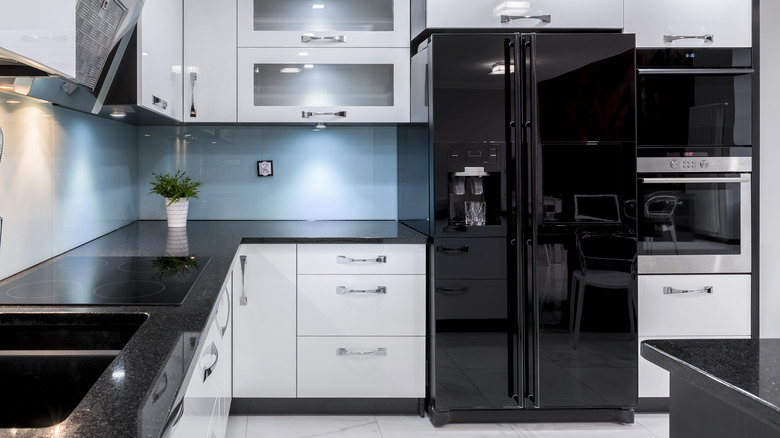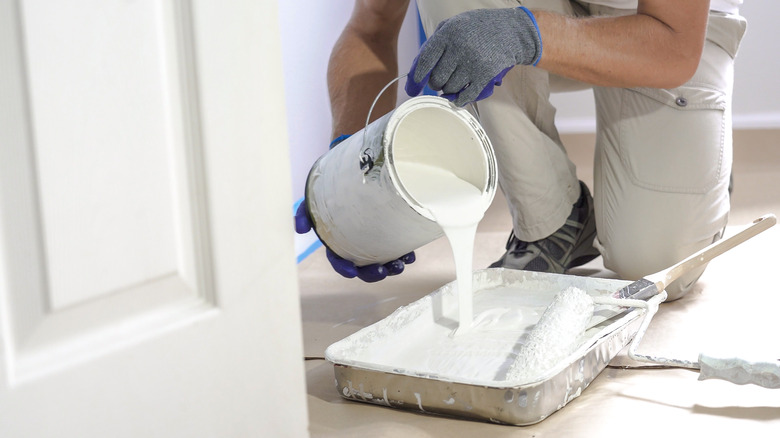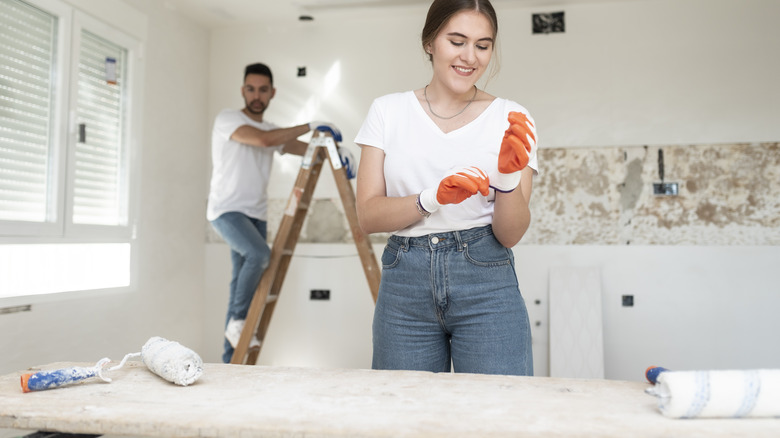The Fun Design Trend That'll Turn Your Refrigerator Into A Message Board
We may receive a commission on purchases made from links.
Our appliances quickly set the tone for our kitchens, the refrigerator being one significant component that can make or break the space. Unfortunately, if you are unhappy with your fridge, it's a thousand-dollar endeavor to replace it. But what if we told you that an easy DIY could be the answer to your design qualms? Using chalkboard paint, you can completely transform your fridge and, thus, kitchen, getting a new look and a convenient message board all in one.
Our refrigerators are a highly personable part of our kitchens, showcasing several things like family photos, report cards, grocery lists, weekly calendars, and endearing art from the little ones in our lives. Curating this small part of the kitchen will make a more considerable difference than one might imagine, and all you need is chalkboard paint, magnetic primer, and a couple of tools to make the painting process go smoothly. In an affordable DIY that will take no more than a few days and some patience, you can have your fridge looking brand new and ready to hold all the chalk-made notes and art your heart desires.
Supplies for your chalkboard fridge
As with any DIY project, you'll want to gather all needed supplies first and foremost. The list of materials is on the simpler side, with chalkboard paint, magnetic primer, paint tape, a paint roller, an angled paint brush, and drop cloths making the cut. As you search for the chalkboard paint you'd like to use, ensure you understand the difference between chalk paint and chalkboard paint. They are different as chalkboard paint gives the proper surface for writing across it, while chalk paint is only a matte, dusty type of paint that won't have the desired erasable properties. Chalkboard paint comes in various colors and doesn't have to be strictly black; hardware stores like Lowe's carry several options.
The magnetic primer is arguably the most crucial component. Without it, you'll be very disappointed to find magnets no longer stick to your fridge with layers of paint covering it. While the magnetic primer won't create as strong of a magnetic pull as your fridge without the paint, it'll still be sufficient to hold magnets. This type of primer can be a little expensive, typically costing between $20 to $50 on Amazon, depending on brand and container size, but it's essential. For convenient shopping, paint tape, brushes and rollers, and drop cloths can also be found on Amazon. However, a perk to buying paints and primer at a department store is they can thoroughly mix and prepare them instead of you doing it by hand at home.
Turning your fridge into a chalkboard
Before setting your fridge with magnetic primer, thoroughly clean it and seal off all needed areas with paint tape, such as the handles, water dispenser, and gaskets. Additionally, lay out drop cloths over the surrounding areas as needed. Ensure your primer is well mixed and has no separation issues before applying it. Follow the can's directions and recommendations for the number of coats you should use. Allow each layer of primer to dry completely before adding another. The paint roller will be great for quick all-over coverage, with the angled brush being useful for touch-ups and more detailed lines. The primer must be dry before moving on to the chalkboard paint, or you'll have some sticky and clumping issues.
The number of layers for the chalkboard paint will depend on your desired coverage, but remember that the thicker the application, the less magnetic pull you'll have. Two or three layers are common, and again, allow each layer to dry fully before adding another. It's suggested to let the paint cure for at least three days before taking chalk to it. Keep in mind that chalk dust will be prominent with this activity, which may not be the most convenient for the kitchen. The mess will vary based on how often you use and erase the chalkboard. If the dust is unappealing, consider painting a portion of the fridge rather than the entirety. Dry-erase paint is also an option, using markers rather than chalk.


